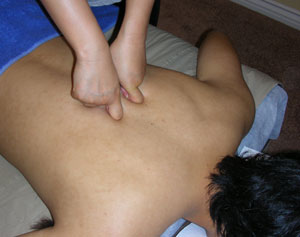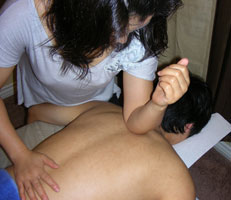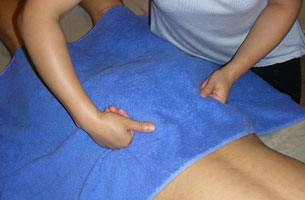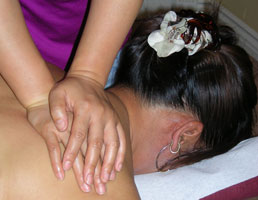Tuī Ná or pinyin: "tuī ná", is a form of
In Chinese history... Tuī Ná dates back to 1700 BC.
To those who have experienced both acupressure and Shiatsu or a Chinese Deep Tissue massage—a Tuī Ná session may seem like a cross between the two. Like Chinese Deep Tissue and Shiatsu, Tuī Ná uses rhythmic compression along energy channels of the body, as well as a variety of techniques that manipulate and lubricate the joints.
Like acupressure, Tuī Ná directly affects the flow of energy by holding and pressing the body at acupressure points. To a Westerner, Tuī Ná is the form of Asian bodywork most closely resembling conventional western massage. Many of the techniques are similar—gliding (known as effleurage or Tui), kneading (petrissage or Nie), percussion (tapotement or Da), friction, pulling, rotation, rocking, vibration, and shaking. But that is where the similarities end... unlike a simple American style massage—the intent of Tuī Ná is more specifically therapeutic!
One of Tuī Ná's advantages over European and Western style massage is the therapist's ability to focus on specific problems, especially chronic pain associated with the muscles, joints, and skeletal system. This technique is especially effective for joint pain, such as arthritis, sciatica, muscle spasms, and pain in the back, neck, and shoulders. It also helps chronic conditions such as insomnia, constipation, headaches (including migraines and cluster), and the tension associated with high stress.
When we first introduced Tuī Ná in 2010… no one had ever heard of it, much less able to pronounce it. Now it is our most popular and requested massage... over 35,000 smiling customers have enjoyed it—and call it the 'Noodle’ Massage!
|
When Wendy is performing Tui Na, she does not simply work on the muscles, bones, and joints. She works with the energy of the body at a deeper level. Simply put... she senses the client's body with her hands and is able to assess the distribution of energy and affect its flow. As with other styles of Chinese bodywork, Tui Na is designed to prevent problems, not just correct them... by keeping the body's energy in balance - health is maintained. This is true not just for physical health... but for mental and emotional well-being as well. |

|

|

|
 |
 |
 |
|
Wendy was born in Xi'an, China. Before moving to American in 2006, she was a Registered Nurse in the Chinese Air Force for over 17 years. In Chinese medicine, therapeutic massage is part of every patient's daily recovery process and includes such therapies as Chinese Relaxation, Deep Tissue, Relaxation, Tuī Ná, Pre/Post Operative or Maternity, Cupping, Hot Stones, or a combination of these therapies. |